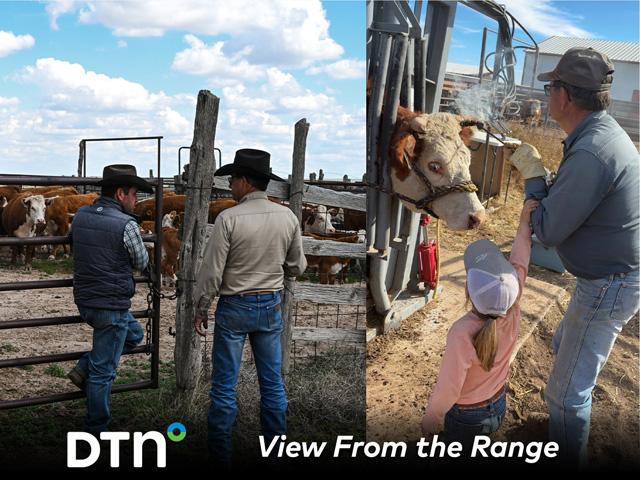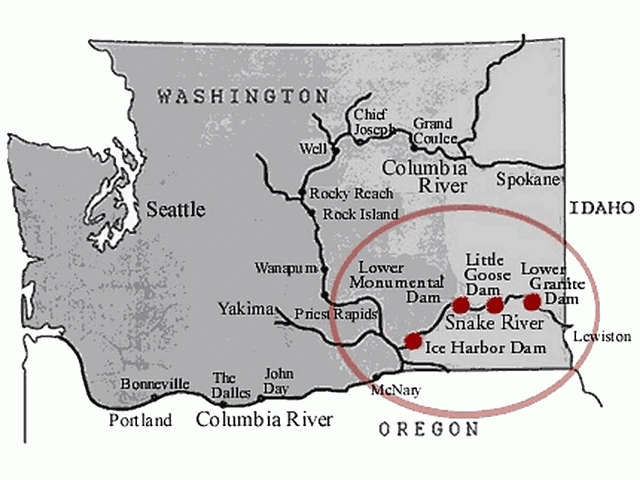Snake River Dam Reports Spark Debate
Wheat Growers Push Back on White House Reports to Remove Snake River Dams
OMAHA (DTN) -- Farmers in the Pacific Northwest would lose a critical barge shipping route if the federal government follows through on a pair of reports released Tuesday by the White House.
The White House Council on Environmental Quality -- including four federal agencies -- released a pair of reports supporting the need to breach or remove one to four dams along the Lower Snake River as a way to boost recovery of salmon and steelhead in the region.
The National Association of Wheat Growers cites that the CEQ reports fails to highlight any benefits of the dams, notably "transportation, navigation, and energy benefits of the river system and the negative impacts dam breaching would have throughout the entire agricultural industry and rural communities."
DEVASTATING ECONOMIC IMPACT
Nicole Berg, a farmer from Washington state and president of NAWG, said wheat farmers see the benefits of barging grain through the Snake River system. The system provides wheat with access to the Pacific Rim and exports to more than 20 countries.
"The idea of breaching the dams on the Lower Snake River would have a devastating economic impact on the livelihood of wheat growers beyond the PNW," Berg said.
The four dams -- Lower Granite, Little Goose, Lower Monumental and Ice Harbor -- are at the center of a decades-old fight over salmon and steelhead fish recovery and migration in the Columbia and Snake River basin.
The Snake River dams support about 60% of all wheat exports out of the PNW area, or between 80 million bushels (mb) to 100 mb annually.
THREAT TO FISH
One of the Biden administration reports released Tuesday cites the dam system as one of the biggest threats and limiting factors to improving fish populations.
P[L1] D[0x0] M[300x250] OOP[F] ADUNIT[] T[]
"Business as usual will not restore the health and abundance of Pacific Northwest salmon. We need a durable, inclusive, and regionally-crafted long-term strategy for the management of the Columbia River Basin," said Brenda Mallory, chair of CEQ, who developed the plan to overhaul the federal government's role in the Columbia River system.
Tribes in the PNW region have long maintained that the dams took away their ability to fish and a coalition of tribes and environmentalists have pushed to remove the dams.
SOURCE OF POWER
The dam removals would not only end barge traffic for grain, but power companies in the region would also have to find a way to replace the hydro-electric power generated by the dams. The dams provide enough low-carbon energy to power more than 800,000 homes. The Department of Energy report released Tuesday estimated it would cost between $11 billion and $19 billion to replace the power now coming from the dams by 2045.
Groups such as NAWG and other shippers who defend the dams point to the cost of removal, but the federal government already has spent an estimated $17 billion to try to recover populations of salmon and steelhead trout, and the fish are still both considered endangered in the Snake River basin.
NAWG also had sent comments Monday to Washington Gov. Jay Inslee and Sen. Patty Murray, both Democrats who are putting together their own report on the report on salmon recovery and the Snake River system.
VALUABLE SHIPPING OPTION
NAWG noted a single four-barge tow carrying wheat moves the equivalent of 538 semi-trucks. Barges are the lowest-cost shipping option as well.
A draft report for Inslee and Murray released in June had already noted price benefits of barge traffic. Removing the dams would likely lead to railroads hiking their rates as well, NAWG noted in its comments.
"While railroads and trucks compete with barge companies to move grain, farmers and grain handlers would be held captive without barges," NAWG stated.
Inslee and Murray had public comment on their own independent report on dam removal that pegged the costs somewhere between $10 billion and $27 billion. That draft report also concludes that the best way to spur salmon recovery would be to remove the dams.
STATEMENT SLAMS BIDEN ADMINISTRATION
Republican members of Congress who represent much of the region involved issued a joint statement "slamming" the Biden administration reports calling for breaching the dams.
"Today's release of two reports from the Biden Administration's Council on Environmental Quality (CEQ) confirms what we have suspected for some time -- they are cherry picking points to justify breaching the Lower Snake River Dams, which will permanently and negatively impact our way of life in the Pacific Northwest," the GOP lawmakers stated.
The members of Congress also stated it appears the administration has been working on an agreement with plaintiffs in a lawsuit that would lead to removing the dams.
The GOP lawmakers on the letter included Reps. Dan Newhouse, Cathy McMorris Rodgers, Jaime Herrera Beutler of Washington, Cliff Bentz of Oregon, Russ Fulcher of Idaho and Matt Rosendale of Montana.
Rep. Mike Simpson, R-Idaho, has gone the other direction and proposed a $33 billion bill to remove the dams and replace their power.
White House Environmental Council reports: https://www.whitehouse.gov/…
Inslee-Murray draft report: https://www.lsrdoptions.org/…
Chris Clayton can be reached at Chris.Clayton@dtn.com
Follow him on Twitter @ChrisClaytonDTN
(c) Copyright 2022 DTN, LLC. All rights reserved.




